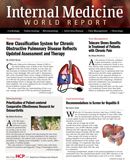Publication
Article
Internal Medicine World Report
Treatment Guidelines Cut Clostridium Difficile Mortality
Author(s):
Clostridium difficile (C. diff) infection is now the leading cause of infectious nosocomial diarrhea in the industrialized world. But by following Infectious Disease Society of America (IDSA) treatment guidelines, clinicians can significantly reduce recurrence and mortality, a Texas Tech University Health Sciences Center School of Pharmacy team reports.
Clostridium difficile (C. diff) infection is now the leading cause of infectious nosocomial diarrhea in the industrialized world. But by following Infectious Disease Society of America (IDSA) treatment guidelines, clinicians can significantly reduce recurrence and mortality, a Texas Tech University Health Sciences Center School of Pharmacy team reports. The guidelines are also endorsed by the Society for Healthcare Epidemiology of America.
Writing in The American Journal of Medicine, Adam Brown, PharmD, BCPS and Charles Seifert, PharmD, BCPS, report on a retrospective study of 180 adults hospitalized at an unnamed county teaching hospital. The researchers are based in Lubbock, TX.
They found big differences in outcomes when patients’ doctors followed the IDSA guidelines, ones written in 2010.
In the guideline-compliant group, which comprised 51.7% of the patients’ prescribers, only 17.2% had complications, vs. 56.3% in those whose prescribers did not follow the rules. The mortality rates were also different, 5.4% in the guideline-compliant group vs. 21.8% in the patients who did not get guideline treatment.
C. diff. infection is on the rise, with 11.2 cases per 10,000 population in 2005, up from 5.5 cases per 10,000 population in 2000, the team reported.
A new, highly virulent strain known as North American Pulsed Field type 1 (NAP-1) is responsible for these increased rates, the researchers said. This strain produces “10 times more toxin than other C. diff. strains” making the outbreaks both more dangerous to patients and difficult to treat. Complications include recurrence, need for surgery, toxic megacolon, and death.
Standard treatment remains metronidazole or oral vancomycin. The authors, both pharmacists, found that “the most significant new recommendation from the C diff guidelines was to use oral vancomycin as the initial treatment in severe or multiple recurrent infections. “ The second-line drug, metronidazole, is cheaper but has up to a 50% failure rate in C. diff infection, they wrote. But they found that despite vancomycin’s apparent superiority, patients with repeated recurrences were often treated with metronidazole. Doctors treating severe infections were more likely to deviate from the guidelines than when they were treating patients with mild infections, the team found.
Unfortunately, and for reasons the researchers said are unknown, “only a little over half of our patients received guideline concordant therapy,” despite the fact that these patients’ treatment happened more than a year after the IDSA guidelines were published. They noted that while clinicians may have been concerned about overuse of antibiotics, “there was no restriction to the use of oral vancomycin” at the study hospital.
“This is not a problem isolated to C. diff. infections but a symptoms of a larger malady,” they wrote, adding that it is estimated that, in the US, patients receive “only slightly more than half of the recommended care during health care visits.”





